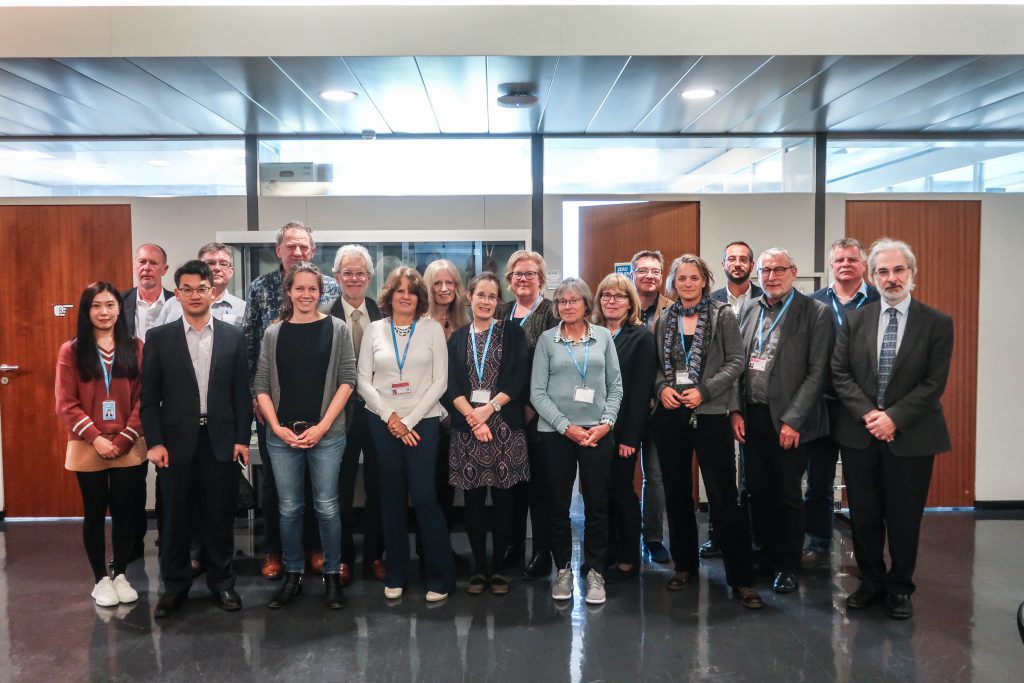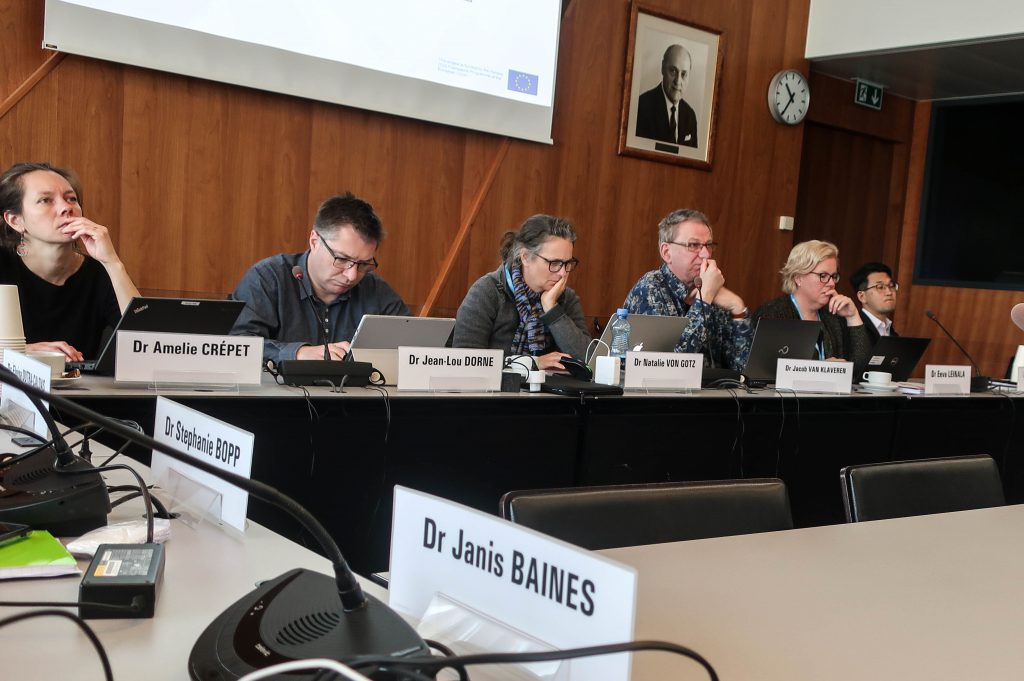The EuroMix project was presented during a session on Cumulative exposure assessment at the IUPAC conference in Ghent held 19 -24th of May 2019. For more information read a brief report from the IUPAC conference here.

The EuroMix project was presented during a session on Cumulative exposure assessment at the IUPAC conference in Ghent held 19 -24th of May 2019. For more information read a brief report from the IUPAC conference here.

EuroMix presented at the National Toxicology Programme (NTP) workshop at US EPA, Washington DC, April 29-30, 2019.

Johanna Zilliacus from Karolinska Institutet, Sweden was invited to present the EuroMix AOP based approach for mixture testing and risk assessment and discuss in a break out group how the EuroMix approach can contribute to development of mixture risk assessment of carcinogens based on in silico and in vitro data. More information on the workshop can be found here.

Prof. Alfonso Lampen presented EuroMix in the 2019 RASS Webinar Series during a section focusing on Mixtures. More information and a link to the presentation can be found here.
WHO HQ, Avenue Appia 20, 1202 Geneva, CH
15 April 2019
The EUROMIX consortium organised the fourth of a series of workshops to discuss international harmonisation of approaches to the risk assessment of combined exposure to chemicals on 15 April 2019. The workshop was held at WHO HQ, Avenue Appia 20, 1202 Geneva, CH. The 18 participants at the workshop were drawn from a range of geographical and regulatory areas, with risk assessors from several regions (Europe, North America, South America and Asia) and organisations (EFSA, JRC, OECD, WHO, FAO, RIVM, BfR, ANSES, FSNAZ, CFSA) present.

The main aims of this workshop were to evaluate the EuroMix Handbook, section by section. On this basis, a number of risk assessment bodies were asked to provide (i) their perspectives on the potential utility of the Handbook in the risk assessment of combined exposure to multiple chemicals by their own organisations and (ii) their feedback on how the Handbook could be improved. Participants were also asked to consider which sections of the Handbook would be most relevant for discussion at the WHO Expert Consultation, 16-18 April 2019, and to identify any potential limitations.
The Handbook was generally well received. Participants felt that it was clearly laid out and that, together with the Toolbox, it should make a significant contribution towards international harmonisation of approaches and methods used in the risk assessment of combined exposure to multiple chemicals.
Participants made a number of suggestions on how the Handbook might be clarified or extended. The Handbook should be “neutral” in the approach and methods used, to provide maximum flexibility for the range of problem formulations that arise in different chemical sectors and regions. The difference among the Handbook, the Toolbox and the User Manual for the Toolbox, and their respective roles should be clarified. The balance of the text, which is extensive in some areas but relatively short in other, equally important, areas should be improved. Guidance should be provided on options where AOPs are not available for the chemicals being assessed, including assessing confidence in AOPs developed de novo for an assessment and options where AOPs cannot be developed. Options should be discussed also for exposure-based grouping rather than only toxicologically-based grouping of chemicals. The section on exposure should be expanded to consider approaches in addition to the full probabilistic assessment described. It should be ensured that templates are suitable for data exchange, for example are harmonised with the OECD templates for data collection. Some guidance should be provided on reporting standards, including suitable summaries for risk assessors and for risk managers.

The participants concluded that there were several sections of the Handbook and modules in the Toolbox that could potentially contribute to risk assessment of combined exposure to multiple chemicals by JECFA/JMPR and that would merit discussion at the Expert WHO Consultation, to be held 16-19 April 2019. However, potential limitations were also identified, including availability of suitable data on exposure, formats for consumption data, transparency of the models used in the Toolbox, and the need for verification of methods, algorithms and software.
A report of the workshop has been prepared and is available here.
The next ISES-Europe Workshop will be dedicated to developing a European strategy for exposure science in Europe.
Registration is now open for the 2nd European Exposure Science Strategy Workshop | 4-5 July 2019 | RIVM, Bilthoven (NL)
Workshop goals
ISES Europe 2019 aims at finalising all steps and key actions for creating a European Exposure Science Strategy by 2020 with an implementation roadmap and goals for 2020-2030.
ISES Europe 2019 has 3 goals:
1. Finalise the 6 thematic action plans as input to complete the European Exposure Science Strategy
2. Define ISES Europe working group actions plans and roadmaps for several exposure sub-themes
3. Discuss strategy implementation and way forward for ISES Europe to support European policy & research agendas
Practical information
Date 4-5 July 2019
Location RIVM (Dutch National Institute for Public Health and the Environment), Bilthoven, The Netherlands
Program Platforms, posters, and interactive sessions on Science to Strategy, Action Plans, Implementation, and Policy and Research Priorities
Extras Pre-workshop short courses on exposure modelling on 3 July 2019, 2-5pm – Sign up now!
For more information on the program overview including pre-conference courses, registration, abstract topics and submission etc., have a look at our brand-new website http://ises-europe.org

On April 16-18, 2019, WHO was responsible, within the EuroMix project, for organising an expert consultation in WHO/HQ Geneva. The consultation involved experts from EU and non-EU countries on the development of guidance for the risk assessment of combined exposure to multiple chemicals.
An overview of the JECFA (Joint FAO/WHO Expert Committee on Food Additives) and JMPR (Joint Meeting on Pesticide Residues) processes and a summary of the EuroMix Handbook and Toolbox were presented.
A practical approach to the risk assessment of combined exposures to multiple chemicals was developed to be piloted by JMPR and JECFA in 2019.
The proposed approach is summarised in a report that can be accessed here.
The final report will be published soon and include the summary of presentations.
EuroMix project will host a series of five webinars.
The aim of the webinars is to provide
May 6, 2019 at 14-16
EuroMix handbook for mixture risk assessment
Johanna Zilliacus, Karolinska Institutet, Sweden
May 7, 2019 at 14-16
Relative potency factors and dose-response modelling in EuroMix toolbox
Johanna Zilliacus, Karolinska Institutet, Sweden
May 8, 2019 at 14-16
Using QSAR and TTC approaches in EuroMix toolbox
Emiel Rorije, RIVM, The Netherlands
May 10, 2019 at 10-12
Assessment of combined dietary exposure in EuroMix toolbox
Jacob van Klaveren, RIVM, The Netherlands
May 13, 2019 at 14-16
Assessment of aggregate exposure in EuroMix toolbox
Marc Kennedy, Fera Science Ltd., UK
All times are Stockholm, GMT+1
Register for the training here.
You can register for one or several of the webinars.
Registration deadline is May 2, 2019.
After the deadline you will receive information on how to connect to the webinar.
For further information please contact: Johanna Zilliacus, Horizontal activity leader for training in EuroMix, Karolinska Institutet, E-mail: johanna.zilliacus@ki.se, tel: +46 8 52483544
The final EuroMix consortium meeting was held 9-11 April 2019 in Egmond aan Zee, the Netherlands.

The aim of the meeting was to:
The meeting was very fruitful and the consortium partners are happy with the many useful and practical outcomes from EuroMix.
The EDC-MixRisk and EuroMix Joint Stakeholder Workshop, The Chemical Cocktail Challenget took place on March 26th 2019 at the Thon Hotel EU in Brussels, Belgium.
The presentations from the workshop can be accessed here.
The EuroMix Stakeholder Workshop, Harmonisation and Usability of the EuroMix tools took place on March 27th 2019 at the Thon Hotel EU in Brussels, Belgium.
The presentations from the workshop can be accessed here.
Hammersmith Campus, Imperial College London, London W12 0NN, UK
25 October 2018
The EuroMix consortium organised the third of a series of workshops to discuss international harmonisation of approaches to the risk assessment of combined exposure to chemicals on 25 October 2018. The workshop was held at the Hammersmith Campus, Imperial College London, London W12 0NN, UK. The 15 participants at the workshop were drawn from a range of geographical and regulatory areas, with risk assessors from several regions (Europe, USA, Canada and Brazil) and authorities (EFSA, JRC, OECD, WHO, US EPA, RIVM, BfR) present.
The main aims of this workshop were to explore ways in which the EuroMix toolbox can contribute to harmonised scientific approaches to the risk assessment of combined exposures to chemicals in the diet, in relevant legislation. In support of this objective, illustrative case studies from the USA and from Europe were presented and discussed, and used to inform guidance for consideration at the final workshop.
The programme and presentations can be accessed here.
In general, there is appreciable alignment of the principles for assessment of combined exposure to multiple chemicals by OECD, EFSA, EPA and other organisations. These all emphasise the importance of problem formulation, including specification of the objectives and acceptable degree of uncertainty for assessment, the basis for grouping chemicals and the choice of assessment approach. There is also general agreement on the need for tiered approaches for both hazard and exposure assessment, to avoid being overly conservative. The use of mode of action information in refining assessment groups has also been broadly incorporated, as has been transparent delineation of uncertainties at each tier. In a number of chemical sectors, there is common application of these principles. However, in the area of pesticides, there are significant differences between the proposed approach in Europe and that which is in use in the USA.
The EuroMix toolbox has potential application, regardless of the approach used, in different sectors or geographical regions, for both data rich and data poor chemicals. Whilst harmonisation of the specific risk assessment methodology might not be possible, at least in the short term, the EuroMix toolbox can contribute to harmonisation of the principles used, in addressing the above issues, the standard of reporting and data templates. EuroMix is developing a Handbook to provide best practice for the range of problem formulations that might concern risk managers and will encourage further harmonisation, to the extent possible. The conclusions of the workshop have been written up in the report of the meeting and will be explored further at the 4th workshop in the series, to be held in Geneva, 15th April 2019.